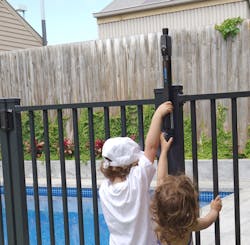Safe Pool Gates Help Save Lives
HUNTINGTON BEACH, California — Drowning is the leading cause of accidental death in children ages 1 – 4 years, with an average of 11 fatal and 22 non-fatal drownings per day. Additionally, 70% of child drownings occur during non-swim times. Children's natural curiosity often leads them to backyard swimming pools, and most children whodrown gain access to the pool through a faulty fence or gate.
To help reduce the risk of child drowning the National Drowning Prevention Alliance (NDPA) has developed five layers of protection. The first and most important layer is a barrier that limits access to the pool and an alarm to alert you if someone enters the pool area unexpectedly. Fencing provides a constant barrier, but the fence is only effective if the gate and gate hardware are in good working order. Checking the pool gate is crucial for drowning prevention, yet only 30% of pool owners do this once a year.
To raise awareness of the problem and provide education on how to check and maintain a pool gate, D&D Technologies along with the NDPA established Check Your Pool Gate Month, starting on May 1st. Check Your Pool Gate Month reminds pool owners to ensure their pool fences, gates, latches, and hinges are secure and working properly, with the aim to reduce child drownings by making it harder for them to access the pool. For every child that drowns, another 7 experience a non-fatal drowning, and 40% of these children require further care. A few minutes is all it takes to check a pool fence and gate, and this simple task done regularly could help save a child’s life.
Safety Checklist for Pool Gates
- Gate should open outwards, away from the pool
- Gate latch release knob should be out of reach of children under 5. (check local codes/standards from minimum requirements)
- Fence should be at a minimum height to comply with your region and encompass the pool area. (check local codes/standards for minimum requirements)
- Maximum clearance from finished ground surface is no more than 4” (100mm)
- Fence perimeter must have adequate distance from other climbable objects or structures
- Gate must be self-closing and self-latching
- Gate hinges are reliable, self-closing, tension-adjustable, rust free and bind free
- Gate latch must be adjustable for height and width
- Gate latch cannot be key locked in the “open” position
- Gate latch cannot be opened using implements or force
- Gate will shut and latch securely from any position, including from resting on the latching mechanism
- Gate complies with all relevant United States Codes/Standards and legislation for pool safety
Use the links below for more information on pool safety and compliance:
National Check Your Pool Gate Month

